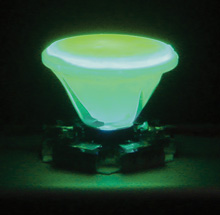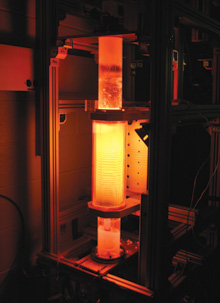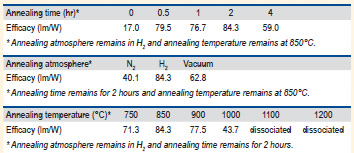|

Techniques to Improve Green Phosphor for Superior White LEDs

An SPE LED package with a green phosphor when excited by a blue LED excitation light source.

An electric laboratory furnace anneals phosphors to temperatures up to 1200°C.
|
The performance of a phosphor-converted (PC) white LED is influenced by the efficiencies of the LED chip, the down-conversion phosphor, and the packaging of these components. A white LED with superior performance requires a spectral power distribution that can provide chromaticity coordinates on the blackbody locus, high CRI, and high luminous efficacy. In these terms, the phosphor’s emission spectrum influences the overall performance of the white LED significantly.
LRC researchers investigated a “green” phosphor for its performance and ability to improve the efficacy and color of a white LED.
EXPERIMENT
As the first step, a simulation exercise was conducted to understand how luminous efficacy and CRI are affected by the phosphor emission spectrum, namely, the peak wavelength and the full-width at half maximum (FWHM). It was shown that a green phosphor with a 555 nm emission peak and 60 nm FWHM together with a red phosphor with 640 nm emission peak and 70 nm FWHM can achieve a good compromise between high luminous efficacy and high CRI when excited by a blue LED. This analysis set the requirement for an ideal emission spectrum of a single phosphor that can be used in a white LED. Based on the simulation, a SrGa2Se4:Eu2+ phosphor with a 555 nm peak emission wavelength and60 nm FWHM was investigated to further improve its performance through post-synthesis annealing.
LRC researchers investigated how post-synthesis annealing conditions—1) annealing temperature, 2) annealing duration, 3) annealing ambient atmosphere—affect phosphor performance. At each step, one condition was changed while the other two were held constant. Each phosphor sample was characterized, in terms of external quantum efficiency and emission properties, in a remote phosphor scattered photon extraction (SPE) package.
RESULTS
Systematically changing conditions to achieve the best phosphor performance resulted in an optimized post-synthesis annealing condition for the SrGa2Se4:Eu2+ phosphor:
- • Duration = 2 hrs
- • Ambient atmosphere = hydrogen (H2)
- • Temperature = 850°C

Experimental results of the SPE PC green-phosphor LED with phosphors annealed under different time, ambient atmosphere, and elevated temperature conditions. The results were used to determine the optimal phosphor annealing conditions for the best luminous efficacy.
TECHNICAL REPORTS & PUBLICATIONS
Zhu, Y., P. Dutta, and N. Narendran. 2010. Post-synthesis annealing effects on SrGa2Se4:Eu2+ phosphors with peak emission wavelength in the green gap. Tenth International Conference on Solid State Lighting, August 1-5, 2010, San Diego, CA, Proceedings of SPIE 7784: 77840P.
Full-text PDF 
Project Summary Sheet (2010) 
SPONSORS
Link Foundation Energy Fellowship Program
Auterra Inc.
New York State Energy Research and Development Authority (NYSERDA)
New York State Office of Science, Technology and Academic Research (NYSTAR)
|


